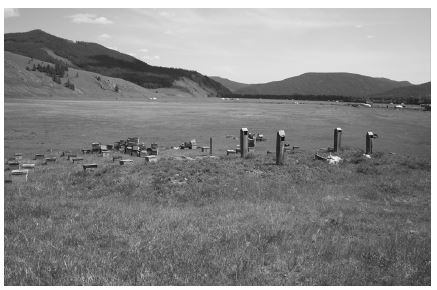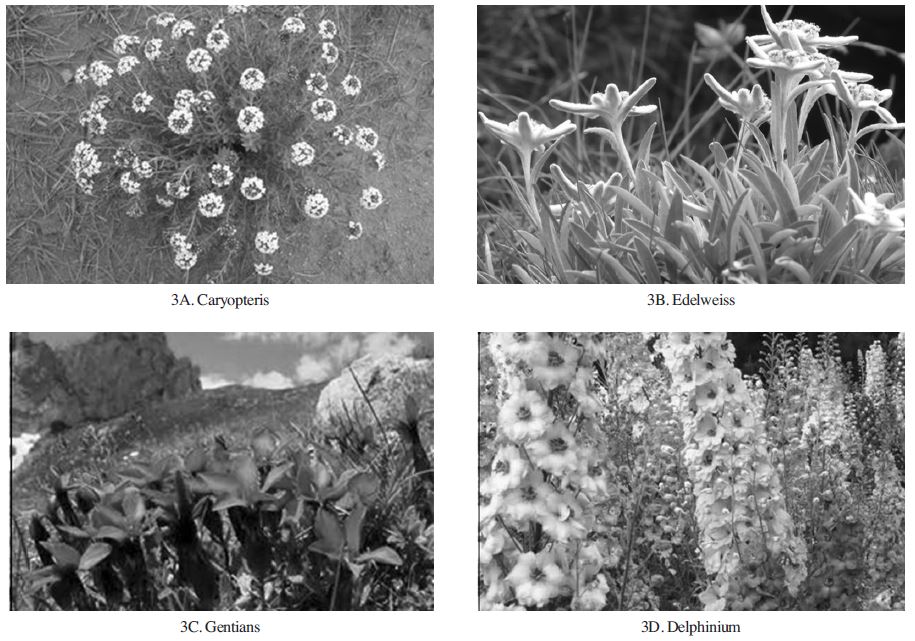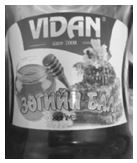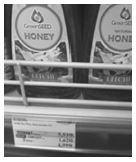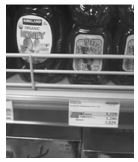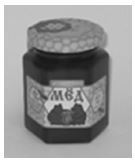
Introduction to Beekeeping and Melliferous Plants in Mongolia
Abstract
In Mongolia where most parts are grassland, there are still many livestocks raised in the nomadic style and thousands of flowering plants surround. The grassland ecosystems go through a very cold winter when the temperature usually falls below minus 40 degree Celsius, and are attracting honeybees and other flower-visiting insects during the three months of growing seasons. In Mongolia, the Northwest administrative region, Aimags province, is mostly closely related to honey production in Mongolia. Melliferous plants include ones in Liliaceae, Orchidaceae, Parnassiaceae, Ranunculaceae, Rosaceae, Scrophulanaceae, Lamiaceae, Fabaceae, Caryophyllaceae, and Asteraceae. Beekeeping is mainly migratory, with honeybee races, Grey Russian, Carpathian and Caucasian. The honey products found in the market of Ulanbaatar are mostly cheap ones imported from Russia and China, with rarely domestic products. On condition that Mongolia could develop its own honey and other beekeeping products, it would add more value on the Mongolian products by themselves and turn to improve the economy of farmers and the nation as well.
Keywords:
Grey Russian, Carpathian, Caucasian, Beekeeping products, EconomyINTRODUCTION
Mongolia is located in Central Asia and a country with the traditionality of nomadic cultures and historic civilizations in Asia. Mongolia is the land-locked between Russia and China, limited in domestic market capacity, surrounded by a wide range of the high altitude mountains, and allowing ample livestock cultivation.
The entire land of Mongolia covers 156,650 hectares of area with about 16 times larger than the South Korea, accounting for about 80 percent of the total arable land, but about 99 percent of the arable land is used as only pasture. The extensive use of pasture and grassland could be an important topic of study in Mongolia, for the vast pool of wild grasses and flowers on the pasture would be the backbone of Mongolia's livestock industry after they have survived so severe Mongolia continental climate for a long time (Ariunzaya et al., 2016).
The studies supplies an overview about the melliferous plants and beekeeping related with honey-producing areas in Mongolia.
MATERIALS AND METHODS
All data used for the studies were obtained through the Government and Nation University libraries or the Internet, and the survey teams also visited directly the markets in Ulaanbaatar of Mongolia from November 2015 to May 2016. Furthermore, the teams visited Terji National Park and met a migratory beekeeper to survey Mongolian beekeeping with the prepared questionnaire. After collected data, the colloquium and seminar were held in Mongolia International University to emphasize Mongolian beekeeping industry and the environment conservation
RESULTS AND CONSIDERATIONS
General Trends in the Traditional Industry of Mongolia
The major industries of Mongolia include mining, agricultural industry, tourism, textile manufacturing, wholesale and retail manufacturing. Based on the industrial composition of GDP (Table 1), mining and wholesale and retail are the largest industries, accounting for 17 percent of GDP. The portion of the mining industry decreased to 17.0 percent, but the portion of agricultural industry, increased by 13.6 percent because of the continuous governmental support and the climate changes of global warming. Still, more than 21 percent of workers still account for the other services, such as financial & insurance, public administration, electricity, gas, accommodation, food service, human health, arts, and so on.
Manufacturing accounted for more than 9 percent of the total GDP. Mongolia has many difficulties in generating manufacturing industries in terms of grassland ecosystems, water resources, cheap labor, and the infrastructure of energy and transportation. Therefore, it would be desirable to establish proper industrial policies considering the climate and environment of Mongolia rather than nurturing the manufacturing industry by force. The agriculture and real estate industry has recently grown steadily, and the economic growth on the basis of the mining industry have generated a kind of expending effect into the other services.
Agriculture and Livestock farming in Mongolia
Mongolia is one of the few remaining nomadic nations on the earth. Although the portion of the livestock farming in the agriculture industry has declined compared to the past, it still accounts for significant weight in terms of gross domestic product and workers. In particular, it should not be overlooked that the agriculture and livestock industry has been a profound influence on the Mongolian society, especially in regards to cultural and emotional aspects (Badarch et al., 2012).
In the industrial sector, Mongolia has a greater proportion of livestock farming and breeding, especially cattle, horses, sheep, goats, and camels. In addition, there is a growing number of poultry farms raising the pigs and chickens. In particular, the death toll of sheep and goats was so numerous that many nomadic people abandoned their homes and moved to the cities because of the difficulties of living (Otgonjargal et al., 2006).
Most of the agricultural land is pastures land (96.2% in 2015 data), and the arable land is less than 1% of the whole agricultural land (Table 2). Among them, the area of farmland grew significantly larger, and the area of potatoes and vegetables grew. The other lands are used for the special needs of Mongolia as a landlocked country through negotiation for access to the sea, to improve the efficiency of transit transportation through the territories of foreign countries.
Mongolia imports large amounts of food from China, and if considering a little extended portion of the arable land, it is believed that Mongolia will be self-sufficient in food supplies. This will also bring important import substitution effects in terms of agriculture. Along with increasing arable land, agricultural production is also increasing greatly. Forage crop also was increased more than twice as much as preparations for winter feed of the traditional livestock and for the raising poultry of pigs and chickens.
Apiculture in Mongolia
In the northern part of Mongolia, which is surrounded by Selenga River and its tributary streams, it is a good breeding ground for honey bees because there are the blossom of the mellifereous plants distributed. Traditionally, the apiculture was not developed widely in Mongolia, but in the first time, Mr. Zhamts began beekeeping in the Selenge region by the effect of Russia.
The beekeeping is mainly migratory for the searching of the melliferous plants with the stack of bee hives and all equipments for beekeeping have been supported by Russia. The races of honeybees are Grey Russian, Carpathian, and Caucasian. According to Mongolian Beekeeper Society, approximately 450 beekeepers have 7,700 hives, but 9,900 hives are currently registered in government entries, and more than 200 ton of honey has been produced in 2015.
The hardest part of the Mongolian beekeeping industry is the entrance of the winter seasons in Mongolia, which have to withstand the sever freezing temperatures. It was discovered that the wintering ground tunnels are used for the bee colonies to survive for such a low temperature as minus 40 degrees Celsius and to feed them during the long winter (Fig. 1 and 2).
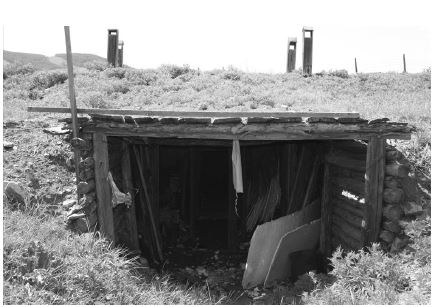
Entrance to the beekeepers’ wintering site of Mongolia, using underground tunnels (about 30 meters deep).
Maedow and Flora in Mongolia
Mongolia is the ninth largest country and located in Central Asia. Because of the hot, short summer and long, cold winter, and a rare rainfall of 20 to 35 centimeters per year, Mongolia has mostly small shrubs, but which are very diverse and are becoming a valuable food for livestock and wild foraging insects.
The most common flowering plant in Mongolia is plants in genus Caryopteris (층꽃나무속 Lamiales, 꿀풀목: Lamiaceae, 꿀풀과) which has distinctive scent from the leaves, and the color of the flowers is white or blue (Fig. 3A). The famous wild plant in Mongolia is Edelweiss (에델바이스, Leonto-podium alpinum, Asterales, 국화목: Asteraceae, 국화과) which can be 3 to 20 centimeters and its leaves are covered with white fur and shaped like wool and, used for medicinal purposes (Fig. 3B).
The third most famous Mongolian plant is plants in geners Gentiana (용담속 Gentianales, 용담목: Gentianaceae, 용담과) which is found in the relatively mild regions of Mongolia with about 400 species, as well as around Asia and around the world, the color of flowers is blue (Fig. 3C).
There is also a plant in a genus Delphinium (제비고깔속 Ranunculales, 미나리아재비목: Ranunculaceae, 미나리아재비과) flower found in the grassland and mountain slopes of Mongolia. In the tip of a long stem (10cm or more), a small purple flower blooms and leaves the pollen, and bumble bees and butterflies in the flower pot help the pollen transfer and fertilization. It has the function of medicinal herbs (Fig. 3D).
Other flowers were found in Mongolia. A plant in genus Rhododendron (진달래속 Ericales, 진달래목; Ericaceae, 진달래과) is composed of large leaves and small flowers, which are commonly used in mountainous regions of the northern hemisphere, and are frequently used for the ornamental purpose, and the horses were reported to have died of eating these poisonous plants. Also, plants in Ancolies (genus Auuilegia, 매발톱꽃속 Ranunculaceae) is a lovely plant found in the grasslands of Mongolia, and its while calyx can be seen in harmony with the purple pink flower. The central pollen is yellow colored.
Mellifereous Plants in Mongolia
In Mongolia, there are about 2,800 kinds of honey-producing plants, the melifereous plants, which exist with a wide range of meadows and a tenacious vitality. In Mongolia, the possibilities of resources for plants with strong vitality are endless.
The figure below shows where Mongolia's honey-producing plants are prevalent. As shown in Table 3, it is understood that Huvsgul (Khövsgöl, 49°38′N 100°10′E), HentI (Khentii, 47°19′N 110°39′E), Hangai (Khangai district of Arkhangai Province, 47°23′N 101°30′E), Mongol Daguur (49°42′0′′N 115°6′0′′E), Hayangar (Khalkhgol distirct of Dornod Province, 47°37′53′′N 118°37′3′′E), Hovd (Khovd, 47°0′N 92°45′E), Mongol Altai (Govi-Altai, 45°30′N 95°30′E) of northeastern Mongolia are equal to the areas of high honey-product of Mongolia farmers (Fig. 5).
Actual visit and investigation to Mongolia bee keepers
The results were carried out by visiting a Mongolian beekeeping farmer with the already-made questionnaire. On June 12, we surveyed one of beekeeping place in Gorkhi-Terelj National Park, about two hours-driven remote place from Ulaanbatar, Mongolia's capital.
When we visited the apiary on June, it had already been a day after the first harvest of honey (Fig. 4 and 5), and the beekeeping is a part-time, not a main business, and run in parallel with the other livestock industries. If the average annual income was between 1 and 2 million tugrug (MNT) from honey sales alone and it values 45,000 to 900,000 Won from Korean currency (Table 4). The diversity of beekeeping productions and the emphasis on the uniqueness and survival ability of honeybees through the sever winter in Mongolia will develop and improve the beekeeping and local industry in the rural area in Mongolia.
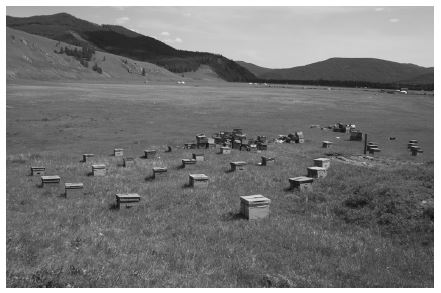
The Mongolian bee hives are set up towards the prairie and the white movable Mongolian tents (Ger) are seen.
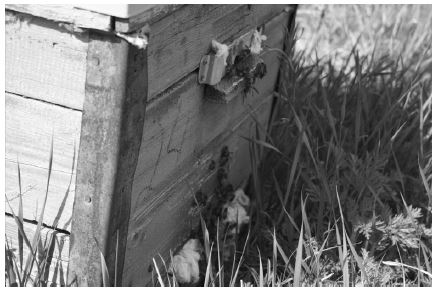
The front view of single hive with the unusual views of hive two entrances separating the upper and lower parts.
Honey products on Mongolian markets
Mongolia was selling about 12 kinds of products using honey. Honey, pollen, wax, milk oil, and pollination are covered, but the actual field investigations have confirmed that Mongolian beekeepers do not know and do not use any other kinds of honey product besides only honey. The Mongol company, Mon-Api, had about 400 hives, had five beekeepers a year, produced two to five tons of honey, and have the local offices at the Ulaanbtar, Darkhan, and Orkhon. The one of the company’s representative products, Muruudliin Khan, is made by mixing honey and milk and is used for the health and healing of the Mongolians.
As you can see in Table 5, honey from Selenga district in Mongolia is not welcome as a popular honey product because the other products imported from China, Russia, and the United States are more universal in Mongolia. Given the uniqueness of Mongolia's regions and weather, it would be advisable to develop and to produce the sufficient value-added products than honey, and other types of honey (Royal Jerry, Propolis and Venom).
CONCLUSION
Anyone who has once experienced the beauty of Mongolia's vast plains is going to want the grandeur of Mother Nature to not be destroyed solely through reckless mining development, overgrazing of the nomadic livestocks, and the car-rushing off roads. And it turns to be the environmental degradation, the lack of safe drinking water, and the desertification of Mongolia.
This study focused on Mongolia's grazing lands, which are still traditional nomadic, and which will have the secondary products of the melliferous plants such as honey production. Not only does this land feed many cattle, horses, sheep, goats or camels that grow naturally in the pasture, but it also serves as a natural source of honey, which certainly plays a role in providing bees and other pollinating insects with honey.
What was lacking in this study is the research on the more pollinating insects than honeybees, which have been looking for the Mongolia grass and wild flowers. There are certainly not only honeybees but also various social bees (Apidae) and the various insects equivalently existed during the short honey blooming season in Mongolia.
Also, due to the lack of data on the development of ranching and the distribution of pasture, the correlation of the crop with the livestock industry was not examined. But as the distribution of the melliferous plants and the honey producing areas in Mongolia (Fig. 6), mostly in northwestern Mongolia was consistent with the data of honey production and melliferous plants.
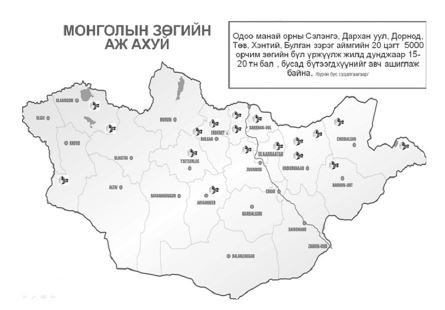
Marking the aimag, the administrative region of Mongolia, with the region to produce 15~20 tons of honey per year, which is consistent with the distribution of the Melliferous plants in Mongolia (Table 3).
Finally, most of the cheap honey circulating in Mongolia market to be more prevalent in Russia, China, and the United States should be replaced with the native honey, considering the add-valued products of Mongolia honey which has their own uniqueness and reflected the local characteristics, the strong survival vitality, and herbal usage of pasture grasses in Mongolia. In addition to the development of beekeeping industry and livestock farming, those studies and research will significantly contribute to the development of the health of the Mongolian people and the economy as well.
Going forward on these efforts of environment conservation will continue to highlight the importance of the grazing resources and protecting the indiscriminate exploitation of Mongolia ecosystem, so that Mongolian government will have the balanced establishment of the long term strategies for the ecological conservation and development.
LITERATURE CITED
- Ariunzaya, A., C. Bayanchimeg, A. Demberel, and M. Ganchimeg, (2016), Mongolian statistical yearbook, p652, National Statistics Office of Mongolia, Ulaanbaatar.
- Badarch, D., R.A. Zilinskas, and P.J. Balint, (2012), Mongolia today: Science, Culture, environment and development, p274, Routledge, London & New York.
-
Bekket, U., A.A. Kechaykin, I.Y. Yevdokimov, P.A. Kosachev, and A.I. Shmakov, (2015), New findings about flora of west Mongolia, Acta Biologica Sibirica, 1, p131-139.
[https://doi.org/10.14258/abs.v1i1-2.910]

-
Christensen, L., M.B. Coughenour, J.E. Ellis, and Z.Z. Chen, (2004), Vulnerability of the asian typical steppe to grazing and climate change, Climate Change, 63, p351-368.
[https://doi.org/10.1023/b:clim.0000018513.60904.fe]

- Choi, S.Y., (1974), New apiculture, p439, Jeeb-Hyun Co, Seoul.
- Damiran, D., and E. Darambazar, (2003), Toxic/ poisonous to plants of Mongolian rangelands, p16, Oregon State Uni-versity, Union.
- Jigjidsuren, S., (1984), Encyclopedia of Mongolian pasture and forages, p376, State Publishing House, Ulaanbaatar.
-
Kechaykin, A.A., A.I. Shmakov, H. Hurka, B. Neuffer, B. Oyuntsetseg, D. Darihand, and N. Friesen, (2014), New findings in the flora of Mongolia. Part 1, Turczaninowia, 17, p57-65.
[https://doi.org/10.14258/turczaninowia.17.1.6]

- Langstroth, L.L., (2004), Langstroth’s hive and the honey-bee: the classic beekeeper’s manual, p409, Dover Publications, Mineola, New York.
- Nösberger, J., H. Blum, and J. Fuhrer, (2000), Crop ecosystem responses to climatic change: proudctive grasslands, p271-292, in Climated change and global crop productivity, eds by K.R. Reddy, and H.F. Hodges, p488CABI Publishing, New York.
- Ortuuz, B., et al , (2013), Medical plants in Mongolia, p248, World Health Organization, Western Pacific Region, Geneva.
- Otgonjargal, C.J., Yu, and S.W. Baek, (2006), The analysis of meat marketing in Mongolia - A case of beef marketing, Bulletin of the Agricultural College, Chonbuk National University, 37, p103-117.
-
Rosssabi, M., (2005), Modern mongolia: from khans to commissars to capitalists, p398, University of California Press, Berkeley & London.
[https://doi.org/10.1525/california/9780520243996.001.0001]

- Sankey, T.T., (2005), 20th Centry forest-grassland ecotones shift and effects of livestock herbivory, p104, Ph.D. thesis, Montana State University, Bozeman.
- Ulziikhutag, N., (1985), Taxonomy of Mongolian fodder and pasture plants, p250, State Publishing House, Ulaanbaatar.
- http://www.mof.gov.mn (Ministry of Fiance)
- http://www.mne.mn (Ministry of Nature & Environment)
- http://www.mofa.gov.mn (Minstry of Food and Agriculture)
- http://aboutmongolians.blogspot.com/2010/03/native-flowersof-mongolia.html (Introduction of Native Plants in Mongolia)
- http://www.en.nso.mn/index.php (Natonal Statistcs Office of Mongolia)
- http://vom.mn/en/p/18473 (Voice of Mongolia)
- https://www.facebook.com/MongolynZgijcdijnNijgemleg/ (Mongolian Beekeeper Society)

